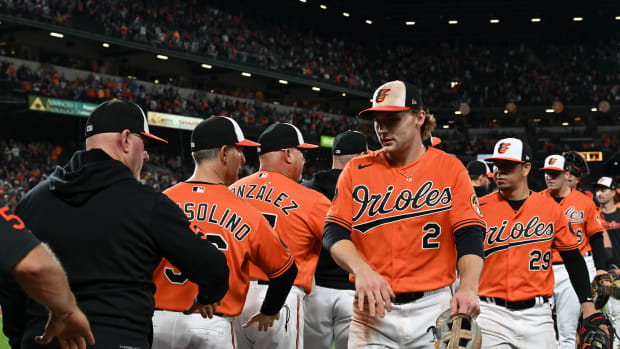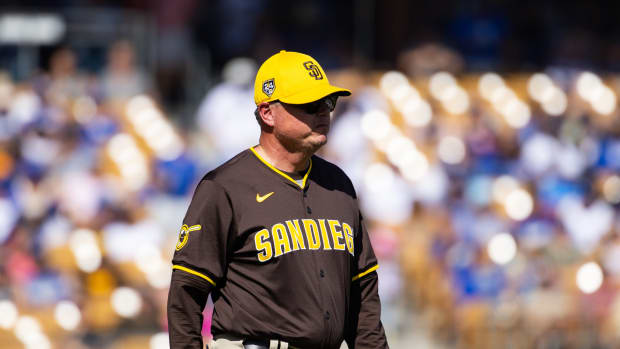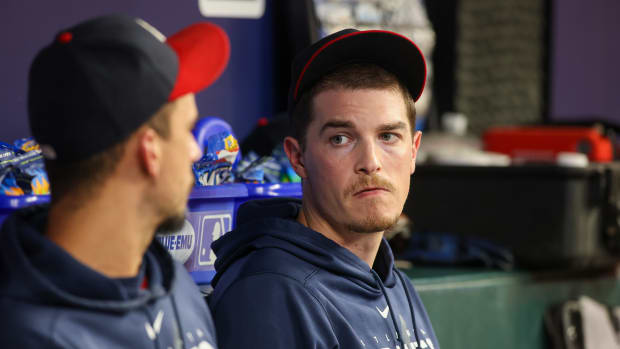The baseball fan's guide to the Super Bowl: Five things you need to know
While baseball fans count down the days to when pitchers and catchers report, the rest of the sports world is providing distraction with a football game, and apparently, it's a big one. Super Bowl LI—that's 51, for those of you whose knowledge of Roman numerals is limited to Rocky movies—will be played on Sunday at 6:30 p.m. ET in Houston's NRG Stadium, pitting the Atlanta Falcons against the New England Patriots.
Because having a football championship at stake isn’t enough to make some of us care about the game—personally, I’m in it for the accompanying feast—it’s worth noting that Super Bowl has several baseball hooks to it.
1. Tom Brady, le receveur
The quarterback of four Super Bowl winners already, Brady is in the conversation for the greatest QB of all time. However, the Patriots superstar could have pursued a baseball career coming out of California's Sierra High School, the same school attended by Barry Bonds and eight other major leaguers. A power-hitting, lefthanded-swinging catcher, Brady hit .311 with eight homers, 11 doubles and 44 RBIs in 61 varsity games, earning all-league honors as a senior. Both his arm and his bat caught the attention of scouts; said his coach Pete Jensen, who was also a scout for the Mariners, "Scouts would see him throw from behind the plate and say, ‘Wow,’ because he really had an outstanding arm.” Jensen recalled a two-homer game by Brady in which one of his shots ricocheted off the team bus, awakening a sleeping bus driver who thought he had parked far enough away.
In a pre-draft workout for Seattle, Brady hit home runs in the Kingdome, but it was the Expos who drafted him in the 18th round in 1995—one round ahead of long-time major league backstop David Ross (drafted by the Dodgers) and future Patriots teammate Lawyer Milloy (drafted by the Tigers as an outfielder). Regarding Brady, Dave Littlefield, who was a national scout for Montreal at the time and later the general manager of the Pirates, said, "He wasn’t as filled out as he is now, but he had a very smooth, nice swing and great athleticism. We would have loved to have had him in professional baseball.”
Though the Expos invited Brady to take batting practice with the team in San Francisco's Candlestick Park after they drafted him, he was determined to go to college (he starred at Michigan). He and the team never formally talked about money, but John Hughes, another Expos scout of the time, said he would have been in line for a bonus equivalent to someone drafted in the top three rounds. Last year, Brady celebrated the 21st anniversary of his being picked with a Photoshopped baseball card that he posted on Facebook, claiming, "I'm so happy I stuck with football!"
No Pipe Dream: Tigers pitcher Michael Fulmer is the AL Rookie of the Year—and a plumber
2. Matt Ryan owes his nickname to baseball
The starting quarterback of the Falcons has a diamond connection of his own, as he pitched and played third base at William Penn Charter School in Philadelphia, which also produced former Phillies general manager Ruben Amaro Jr.. Ryan made the varsity team as a freshman in 2000 and started at third base in his first game against Malvern Prep, for whom his older brother Motts (Motts??) played. In 2008, Penn Charter baseball coach Richard Mellon told ESPN Magazine, "Matt had two hits, no errors, and we won. That's how he got the nickname Matty Ice."
Ryan wasn't good enough to be drafted, but he did become captain of the baseball team (as well as the football and basketball teams) and made the Philadelphia Daily News All-City third team in 2003.
3. More Patriots also have baseball experience
At least three of Brady's current teammates had amateur baseball careers of note. Kicker Stephen Gostkowski went to the University of Memphis on a baseball scholarship and spent four years (2003 to '06) pitching for the Tigers. His numbers were … not good: Though he went 4–5 with a 4.02 ERA as a freshman, the returns soon diminished, and he finished his career with a 7–22 record and a 6.04 ERA in 55 games. Via his own scouting report, "I threw 90 to 92 [mph] and topped out at 94. I had a good fastball, good changeup and below-average curveball, which I think was my problem. I threw a lot of strikes, I just didn't have that 'out' pitch. That was my biggest flaw." Arm trouble and walk-on success as a kicker were factors as well: "It just became pretty apparent my junior year of college that I was going to have a better chance at football. I mean, if I would have played baseball year-round and quit everything else, I think I would have had a shot."
Wide receiver Danny Amendola—who grew up in The Woodlands, a suburb of Houston—played varsity baseball at The Woodlands High School and earned all-state honors as a second baseman during his senior year in 2004. Though undersized, he was aggressive; as he said in 2010, "I had a deal with running over the catcher. I couldn't slide; I'd always have to hit the catcher. I got thrown out of a couple of games because of that in high school."
Left tackle Nate Solder—who is now listed at 6'8" and 314 pounds—was a two-year letterman at Denver's Buena Vista High School, where he pitched and played first base. Solder also played basketball, but he turned down an offer to play at Dartmouth in favor of accepting a football scholarship to Colorado. Linebacker Rob Ninkovich lettered in baseball at Lincoln-Way Central High School in Lenox, Ill., the same high school as Reds pitcher Tony Cingrani.
4. Deion Sanders and Brian Jordan were two-sport stars
Besides Ryan, the current Falcons appear to be lacking in baseball experience, but two of their former players had significant careers in MLB, and both spent time with the Braves as well. Among the 67 players with experience at the top level of both sports, Sanders holds the record for the most games played in the NFL (188), and Jordan holds the record for the most games played in MLB (1,656). Both played defensive back and the outfield.
Primarily a centerfielder, Sanders was originally drafted by the Royals in the sixth round in 1985 but chose instead to go to Florida State, where he played both sports as well as track and field. He was the fifth pick of the 1989 NFL draft by the Falcons, with whom he spent the first five seasons of his 14-year football career (1989 to 2000, '04, 05). Meanwhile, he was a 30th-round pick by the Yankees in '88 and made his major league debut on May 31, 1989, going 1-for-4 against the Mariners as a centerfielder in a lineup that also included Rickey Hendeson and Don Mattingly.
Sanders, who would draw dollar signs in the dirt before each at-bat, got into a famous spat with White Sox catcher Carlton Fisk over his failure to run out a pop fly. He hit just .178/.247/.306 in 71 games over two seasons with the Yankees before being released in September 1990 when the team couldn't find a trade partner; general manager Gene Michael felt that Sanders' focus on football and media attention was hindering his baseball progress. "It's just better we part because of the atmosphere here. In a different town, he might be better," Michael said at the time.
Men on wire: For some MLB players, off-season means changing teams over and over
Sanders signed with the Braves and spent parts of four seasons with them. By far his best season was in 1992, when he hit .304/.346/.495 with a league-high 14 triples (but just six doubles), 26 steals and eight homers in 97 games. He went 8-for-15 with two doubles and five steals in a losing cause against the Blue Jays in the World Series that year, though he had left the team in September due to the start of football season. On May 29, 1994, the Braves traded him to the Reds, and though he was flipped to the Giants 14 months later, it was with Cincinnati that he dabbled again in 1997 (when he played a career-high 115 games and hit .273/.329/.363) and 2001. In 641 career games, he hit .263/.319/.392 for an 89 OPS+ with 39 homers, 186 steals and 5.5 WAR. He fared far better on the gridiron as a standout defensive back and kick returner, notching 53 interceptions, scoring 22 touchdowns, making eight Pro Bowl teams, playing on two Super Bowl champions and earning a spot in the Pro Football Hall of Fame (no word on what his JAWS was).
As for Jordan, he was more highly regarded in baseball and primarily played rightfield. Coming out of the University of Richmond, he was the 30th pick of the 1988 draft by the Cardinals and a seventh-round pick by the Buffalo Bills in '89, though he was cut in training camp. While playing in St. Louis' minor league system, he spent the 1989 to '91 seasons with the Falcons, intercepting five passes as a strong safety. He put football behind him in '92, when he made the Cardinals, going 2-for-5 with four RBIs on April 8 against the Mets. Though he struggled that year, he hit a very respectable .291/.339/.474 for a 115 OPS+ and 84 homers in seven seasons ('92 to '98) with the Cardinals; in '98, he hit .316/.368/.534 with career highs in homers (25), OPS+ (134) and WAR (7.0).
A free agent that winter, Jordan signed with the Braves and made his lone All-Star team the next year, driving in a career-high 115 runs. He helped the Braves to three straight postseason appearances, then was part of a four-player trade to the Dodgers that brought Gary Sheffield to Atlanta. After two years there and two in Texas, Jordan returned to the Braves for his final season in 2006. For his career, he hit .282/.333/.455 with a 105 OPS+, 184 homers, 119 steals, 153 fielding runs (he's third at the position all-time thanks to his great range) and 32.8 WAR.
5. Houston, we have a problem?
This is the third time the Super Bowl has been played in Houston, which means that with Sunday’s game, it will surpass the total number of World Series games played in the city. Super Bowl VIII, played on Jan. 13, 1974 between the Miami Dolphins and Minnesota Vikings at Rice Stadium, was the first. In that one, the Dolphins won, 24–7, to claim their second straight championship. Super Bowl XXXVIII between the Bill Belichick-coached and Brady-led Patriots against the Carolina Panthers was the second game, played at Reliant Stadium (now NRG) on Feb. 1, 2004. Brady passed for 354 yards and three touchdowns as the Patriots won, 32–29, on a 41-yard Adam Vinatieri field goal with four seconds remaining, giving them their second championship in three years.
The only time Houston has hosted a World Series was in 2005, when the Astros—then in the National League—won their lone pennant. Facing the White Sox, they lost the first two games in Chicago. When the Series shifted to Minute Maid Park, Houston lost a 12-inning, 5-hour and 41-minute marathon in Game 3, then a 1–0 squeaker in Game 4. The Astros have only been back to the postseason once since then, in 2015, when they beat the Yankees in the wild-card game but blew a 2–1 series lead to the eventual world champion Royals in the Division Series.
Oddly enough, the city's most famous venue, the Astrodome, never hosted a Super Bowl. The defunct dome, which the Astros called home from 1965 to '99, hasn't hosted an event since 2008; a battle over whether to repurpose it or tear it down continues. It sits adjacent to NRG Stadium and currently functions as a storage facility that will house materials related to the big game.
Two-minute drill
• The Falcons began play in 1966, the same year that the Braves moved to Atlanta from Milwaukee. The two teams shared occupancy of Fulton County Stadium from 1976 to '91, though each had longer runs there. Both teams will move into new venues in 2017, with the Falcons bound for Mercedes-Benz Stadium and the Braves for SunTrust Park.
• The Braves, of course, were originally based in Boston.
• Running back Tyler Gaffney, currently a member of the Patriots' practice squad, played baseball as well as football at Stanford and was drafted by the Pirates in the 24th round in 2012. He hit .297/.483/.441 in 38 games for the team's Class A affiliate in 2012.
• As you might expect, Belichick and former Red Sox manager Terry Francona are good friends who now also share a Cleveland link as well as a New England one, since Belichick coached the Browns from 1991 to '95 and Francona now pilots the Indians.
• Star Falcons receiver Julio Jones wears a bracelet in memory of Savoy Jones, a 15-year-old basketball and baseball star who collapsed and died while on the court on Feb. 5, 2013.
• Of the 93 players who have played for the two teams’ baseball counterparts in their current cities, the lone Hall of Famer is John Smoltz, who spent 1991–2008 with the Braves and part of '09 with the Red Sox.



































